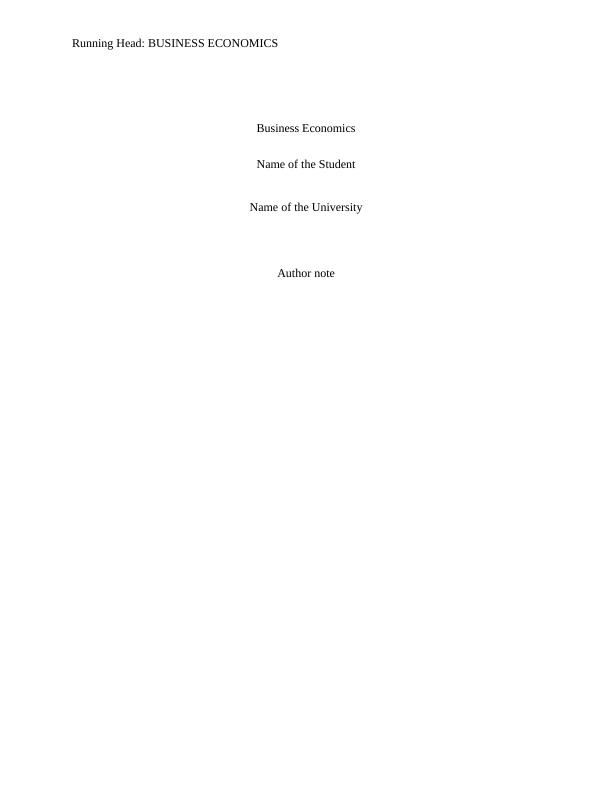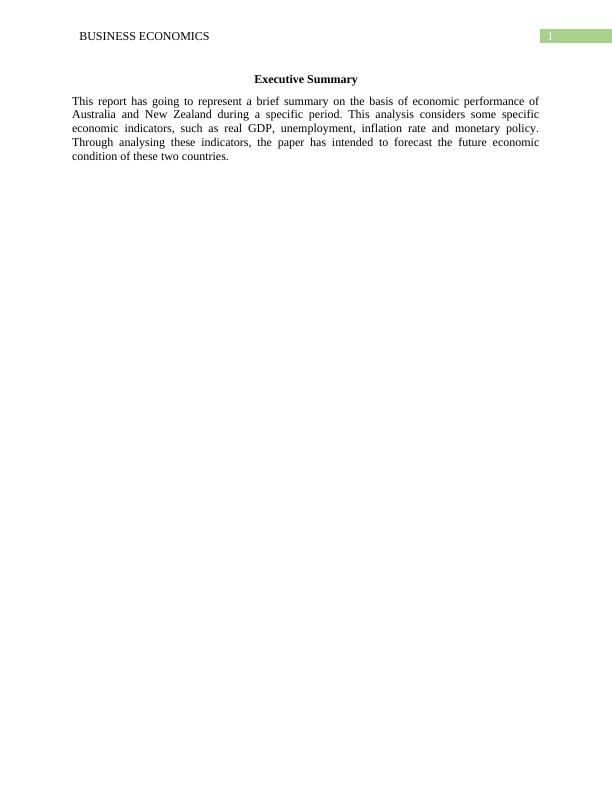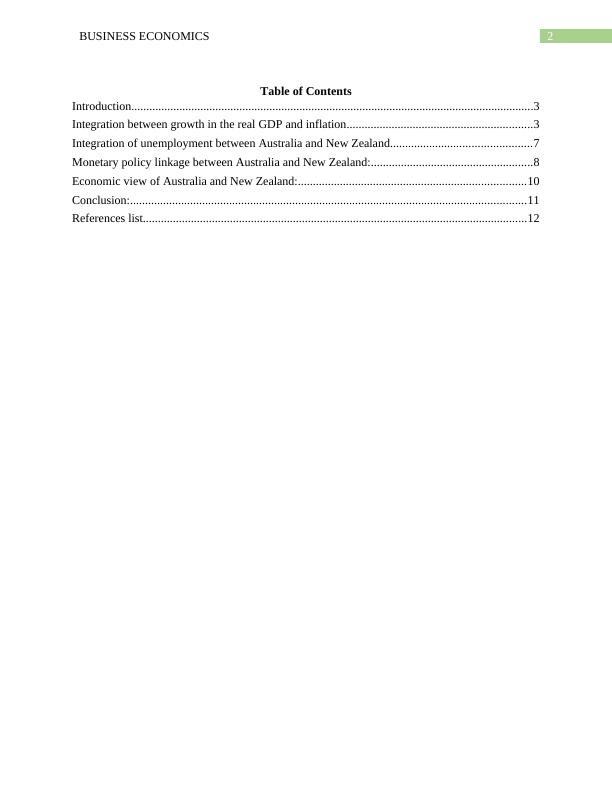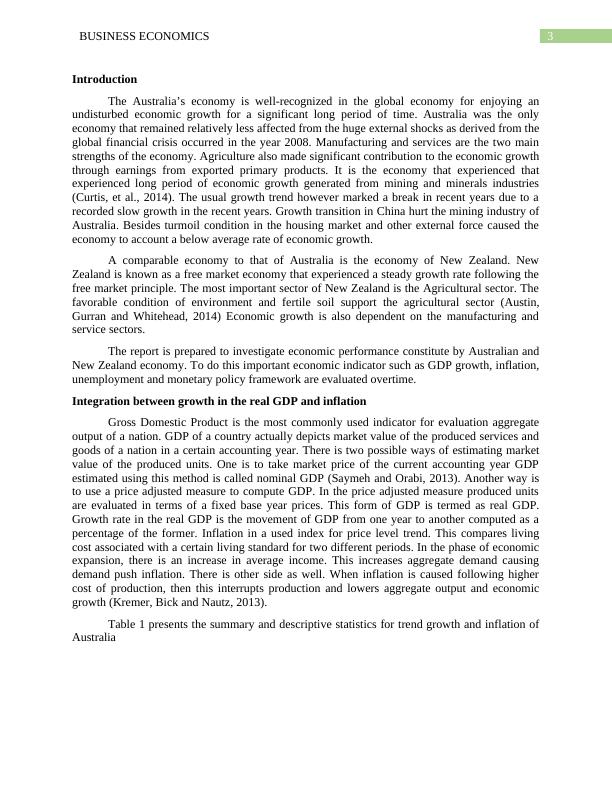Business Economics: Economic Performance of Australia and New Zealand
Added on 2023-06-04
14 Pages4165 Words455 Views
Running Head: BUSINESS ECONOMICS
Business Economics
Name of the Student
Name of the University
Author note
Business Economics
Name of the Student
Name of the University
Author note

1BUSINESS ECONOMICS
Executive Summary
This report has going to represent a brief summary on the basis of economic performance of
Australia and New Zealand during a specific period. This analysis considers some specific
economic indicators, such as real GDP, unemployment, inflation rate and monetary policy.
Through analysing these indicators, the paper has intended to forecast the future economic
condition of these two countries.
Executive Summary
This report has going to represent a brief summary on the basis of economic performance of
Australia and New Zealand during a specific period. This analysis considers some specific
economic indicators, such as real GDP, unemployment, inflation rate and monetary policy.
Through analysing these indicators, the paper has intended to forecast the future economic
condition of these two countries.

2BUSINESS ECONOMICS
Table of Contents
Introduction......................................................................................................................................3
Integration between growth in the real GDP and inflation..............................................................3
Integration of unemployment between Australia and New Zealand...............................................7
Monetary policy linkage between Australia and New Zealand:......................................................8
Economic view of Australia and New Zealand:............................................................................10
Conclusion:....................................................................................................................................11
References list................................................................................................................................12
Table of Contents
Introduction......................................................................................................................................3
Integration between growth in the real GDP and inflation..............................................................3
Integration of unemployment between Australia and New Zealand...............................................7
Monetary policy linkage between Australia and New Zealand:......................................................8
Economic view of Australia and New Zealand:............................................................................10
Conclusion:....................................................................................................................................11
References list................................................................................................................................12

3BUSINESS ECONOMICS
Introduction
The Australia’s economy is well-recognized in the global economy for enjoying an
undisturbed economic growth for a significant long period of time. Australia was the only
economy that remained relatively less affected from the huge external shocks as derived from the
global financial crisis occurred in the year 2008. Manufacturing and services are the two main
strengths of the economy. Agriculture also made significant contribution to the economic growth
through earnings from exported primary products. It is the economy that experienced that
experienced long period of economic growth generated from mining and minerals industries
(Curtis, et al., 2014). The usual growth trend however marked a break in recent years due to a
recorded slow growth in the recent years. Growth transition in China hurt the mining industry of
Australia. Besides turmoil condition in the housing market and other external force caused the
economy to account a below average rate of economic growth.
A comparable economy to that of Australia is the economy of New Zealand. New
Zealand is known as a free market economy that experienced a steady growth rate following the
free market principle. The most important sector of New Zealand is the Agricultural sector. The
favorable condition of environment and fertile soil support the agricultural sector (Austin,
Gurran and Whitehead, 2014) Economic growth is also dependent on the manufacturing and
service sectors.
The report is prepared to investigate economic performance constitute by Australian and
New Zealand economy. To do this important economic indicator such as GDP growth, inflation,
unemployment and monetary policy framework are evaluated overtime.
Integration between growth in the real GDP and inflation
Gross Domestic Product is the most commonly used indicator for evaluation aggregate
output of a nation. GDP of a country actually depicts market value of the produced services and
goods of a nation in a certain accounting year. There is two possible ways of estimating market
value of the produced units. One is to take market price of the current accounting year GDP
estimated using this method is called nominal GDP (Saymeh and Orabi, 2013). Another way is
to use a price adjusted measure to compute GDP. In the price adjusted measure produced units
are evaluated in terms of a fixed base year prices. This form of GDP is termed as real GDP.
Growth rate in the real GDP is the movement of GDP from one year to another computed as a
percentage of the former. Inflation in a used index for price level trend. This compares living
cost associated with a certain living standard for two different periods. In the phase of economic
expansion, there is an increase in average income. This increases aggregate demand causing
demand push inflation. There is other side as well. When inflation is caused following higher
cost of production, then this interrupts production and lowers aggregate output and economic
growth (Kremer, Bick and Nautz, 2013).
Table 1 presents the summary and descriptive statistics for trend growth and inflation of
Australia
Introduction
The Australia’s economy is well-recognized in the global economy for enjoying an
undisturbed economic growth for a significant long period of time. Australia was the only
economy that remained relatively less affected from the huge external shocks as derived from the
global financial crisis occurred in the year 2008. Manufacturing and services are the two main
strengths of the economy. Agriculture also made significant contribution to the economic growth
through earnings from exported primary products. It is the economy that experienced that
experienced long period of economic growth generated from mining and minerals industries
(Curtis, et al., 2014). The usual growth trend however marked a break in recent years due to a
recorded slow growth in the recent years. Growth transition in China hurt the mining industry of
Australia. Besides turmoil condition in the housing market and other external force caused the
economy to account a below average rate of economic growth.
A comparable economy to that of Australia is the economy of New Zealand. New
Zealand is known as a free market economy that experienced a steady growth rate following the
free market principle. The most important sector of New Zealand is the Agricultural sector. The
favorable condition of environment and fertile soil support the agricultural sector (Austin,
Gurran and Whitehead, 2014) Economic growth is also dependent on the manufacturing and
service sectors.
The report is prepared to investigate economic performance constitute by Australian and
New Zealand economy. To do this important economic indicator such as GDP growth, inflation,
unemployment and monetary policy framework are evaluated overtime.
Integration between growth in the real GDP and inflation
Gross Domestic Product is the most commonly used indicator for evaluation aggregate
output of a nation. GDP of a country actually depicts market value of the produced services and
goods of a nation in a certain accounting year. There is two possible ways of estimating market
value of the produced units. One is to take market price of the current accounting year GDP
estimated using this method is called nominal GDP (Saymeh and Orabi, 2013). Another way is
to use a price adjusted measure to compute GDP. In the price adjusted measure produced units
are evaluated in terms of a fixed base year prices. This form of GDP is termed as real GDP.
Growth rate in the real GDP is the movement of GDP from one year to another computed as a
percentage of the former. Inflation in a used index for price level trend. This compares living
cost associated with a certain living standard for two different periods. In the phase of economic
expansion, there is an increase in average income. This increases aggregate demand causing
demand push inflation. There is other side as well. When inflation is caused following higher
cost of production, then this interrupts production and lowers aggregate output and economic
growth (Kremer, Bick and Nautz, 2013).
Table 1 presents the summary and descriptive statistics for trend growth and inflation of
Australia

End of preview
Want to access all the pages? Upload your documents or become a member.
Related Documents
Economics Assignment: Analysis of Economic Indicators for Australia and New Zealandlg...
|13
|4241
|413
The Economy of Australia - ECCON 101 - Economicslg...
|15
|2918
|63
Macroeconomics Performance of Australialg...
|14
|4190
|34
Evaluation Of Macroeconomic Performance of Australialg...
|13
|3244
|47
BUS700 Economic Assignment: Macroeconomic Performancelg...
|14
|3724
|40
BUS700 Economic Performance of Australia Assignmentlg...
|16
|3757
|91
